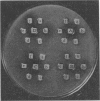Abstract
Recent studies have shown high levels of antibody to the parainfluenza virus group in human sera collected in New England and in other populations in various parts of the world. In view of the importance of animals as reservoirs of viruses affecting man, studies were carried out to assess the level of immunity to the parainfluenza, DA and mumps viruses in domestic animals (cows, swine, dogs, cats, lambs, and sheep) in New England.
Antibody levels were determined by the haemagglutination-inhibition test. The results indicated that parainfluenza 3 was the most prevalent followed by parainfluenza 2 and parainfluenza 1; high levels were also found for DA and mumps viruses.
A modified agar-gel diffusion test for detecting mumps precipitating antibodies was also investigated. Mumps-immune sera showed a reaction against concentrated soluble antigen. A comparison of the agar-gel diffusion method and standard serological methods, including complement-fixation, neutralization and haemagglutination-inhibition, indicated a significant correlation between the various techniques.
Full text
PDF





Images in this article
Selected References
These references are in PubMed. This may not be the complete list of references from this article.
- ABINANTI F. R., HOERLEIN A. B., WATSON R. L., HUEBNER R. J. Serologic studies on myxovirus para-influenza 3 in cattle and the prevalence of antibodies in bovines. J Immunol. 1961 May;86:505–511. [PubMed] [Google Scholar]
- ABINANTI F. R., HUEBNER R. J. The serological relationships of strains of parainfluenza 3 virus isolated from humans and cattle with respiratory disease. Virology. 1959 Jul;8(3):391–394. doi: 10.1016/0042-6822(59)90041-8. [DOI] [PubMed] [Google Scholar]
- ANDREWES C. H., BANG F. B., CHANOCK R. M., ZHDANOV V. M. Para-influenza viruses 1, 2, and 3: suggested names for recently described myxoviruses. Virology. 1959 May;8(1):129–130. doi: 10.1016/0042-6822(59)90027-3. [DOI] [PubMed] [Google Scholar]
- CHANOCK R. M. Association of a new type of cytopathogenic myxovirus with infantile croup. J Exp Med. 1956 Oct 1;104(4):555–576. doi: 10.1084/jem.104.4.555. [DOI] [PMC free article] [PubMed] [Google Scholar]
- CHANOCK R. M., PARROTT R. H., COOK K., ANDREWS B. E., BELL J. A., REICHELDERFER T., KAPIKIAN A. Z., MASTROTA F. M., HUEBNER R. J. Newly recognized myxoviruses from children with respiratory disease. N Engl J Med. 1958 Jan 30;258(5):207–213. doi: 10.1056/NEJM195801302580502. [DOI] [PubMed] [Google Scholar]
- CHANOCK R. M., WONG D. C., HUEBNER R. J., BELL J. A. Serologic response of incividuals infected with para influenza viruses. Am J Public Health Nations Health. 1960 Dec;50:1858–1865. doi: 10.2105/ajph.50.12.1858. [DOI] [PMC free article] [PubMed] [Google Scholar]
- COOK M. K., ANDREWS B. E., FOX H. H., TURNER H. C., JAMES W. D., CHANOCK R. M. Antigenic relationships among the newer myxoviruses (parainfluenza). Am J Hyg. 1959 May;69(3):250–264. doi: 10.1093/oxfordjournals.aje.a119998. [DOI] [PubMed] [Google Scholar]
- DEMEIO J. L., WALKER D. L. Demonstration of antigenic relationship between mumps virus and hemagglutinating virus of Japan. J Immunol. 1957 Jun;78(6):465–471. [PubMed] [Google Scholar]
- DICK E. C., MOGABGAB W. J. Characteristics of para-influenza 1 (HA-2) virus. III. Antigenic relationships, growth, interaction with erythrocytes, and physical properties. J Bacteriol. 1962 Mar;83:561–571. doi: 10.1128/jb.83.3.561-571.1962. [DOI] [PMC free article] [PubMed] [Google Scholar]
- FROTHINGHAM T. E., SANYAKORN C. K. Parainfluenza viruses in Southern Louisiana. Public Health Rep. 1961 Sep;76:765–770. [PMC free article] [PubMed] [Google Scholar]
- HSIUNG G. D., ISACSON P., McCOLLUM R. W. Studies of a myxovirus isolated from human blood. I. Isolation and properties. J Immunol. 1962 Mar;88:284–290. [PubMed] [Google Scholar]
- HSIUNG G. D., ISACSON P., TUCKER G. STUDIES OF PARAINFLUENZA VIRUSES. II. SEROLOGIC INTERRELATIONSHIPS IN HUMANS. Yale J Biol Med. 1963 Jun;35:534–544. [PMC free article] [PubMed] [Google Scholar]
- HSIUNG G. D. The use of agar overlay cultures for detection of new virus isolates. Virology. 1959 Dec;9:717–719. doi: 10.1016/0042-6822(59)90167-9. [DOI] [PubMed] [Google Scholar]
- LA PLACA M., MOSCOVICI C. Distribution of parainfluenza antibodies in different groups of population. J Immunol. 1962 Jan;88:72–77. [PubMed] [Google Scholar]
- Levens J. H., Enders J. F. THE HEMOAGGLUTINATIVE PROPERTIES OF AMNIOTIC FLUID FROM EMBRYONATED EGGS INFECTED WITH MUMPS VIRUS. Science. 1945 Aug 3;102(2640):117–120. doi: 10.1126/science.102.2640.117. [DOI] [PubMed] [Google Scholar]
- McClendon J. H., Somers G. F. Simple Large Scale Ultrafiltration Using Osmotically Forced Dialysis. Plant Physiol. 1955 Sep;30(5):485–485. doi: 10.1104/pp.30.5.485. [DOI] [PMC free article] [PubMed] [Google Scholar]



